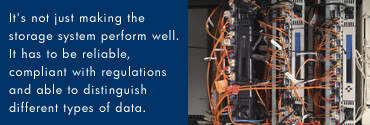
By John Cameron -- Sept. 2006
Desktops, laptops, servers and data centers are packed
with data, and the amount stored is growing at a staggering
rate. In 2005, hard disk manufacturers shipped 30 exabytes;
that's enough to store three million days of HD video
or all the words ever spoken by humans – times
six. With the explosive growth of online multimedia --
particularly video -- that number is forecast to double
in less than three years.
The problem isn't keeping up with demand for capacity
or paying for the raw drives. Increases in recording
density and intense competition among manufacturers mean
the price-per-gigabyte of disk drives is falling by 30
to 50 percent each year.
The real challenge is managing storage systems to provide
fast, accurate access to active data, secure storage
of proprietary data, and reliable access to vast amounts
of archived data -- all while minimizing the loss of
business-critical data to hardware failures or human
error.
Storage management is increasingly making up a larger
part of storage-related IT budgets. Declining costs for
storage infrastructure are being offset by steadily rising
administration costs, as enterprises hire more – and
more experienced – staff to oversee ballooning
storage assets.
Just as in other fields of infrastructure management,
taking human work out of the system reduces the likelihood
of problems, speeds responses to issues, and helps control
costs. In addition, automated storage management has
the potential to increase businesses' agility by handing
any changes to the storage infrastructure in minutes
instead of weeks.
"It's just too much for people to handle. You have
to get machines to do it for you," says Alistair
Veitch, who leads a team of HP researchers working to
automate storage management.
One of the first steps in making this happen, he says,
is to establish goals for data storage. For example,
how long are documents to be kept before deleting or
archiving, and what standards for storage and archiving
do you have to comply with?
These standards may include internal goals as well as
government regulations such as those in the U.S. Sarbanes-Oxley
Act, the Gramm-Leach-Bliley Act and the U.S. PATRIOT
Act, as well as numerous other industry, agency, state
and international requirements. Administrators also need
to implement mechanisms to ensure that there is sufficient
data and/or document redundancy to provide backup in
the event of a failure, but no more than is necessary
for that purpose, since additional redundancy leads to
wasted capacity and version control problems.
HP Labs, HP's central research facility, is developing
better ways to access and manage data and information,
as well as managing the storage infrastructure that makes
it all possible.
Researchers are taking a multi-pronged approach to the
problem, attacking everything from management of the
low-level infrastructure to information lifecycle management
(ILM), which considers every aspect of the life of enterprise
data, breaking it down into creation, operational (actively
reviewed and modified), transitional (occasionally accessed)
and records management (archiving) phases.
"It's not just making the storage system perform
well," says Veitch. "We need to make it reliable
and compliant with regulations. It has to be able to
distinguish different types of data. There are a huge
range of problems to be solved."
ILM systems don't just save storage costs and automate
discovery. They also create opportunities for businesses
to locate and manage information assets by business value,
enabling greater alignment between business and IT.
HP Labs researchers are going beyond current rules-based
systems to build storage systems that understand the
types of storage options, and then use smart classification
of data to seamlessly and automatically migrate documents
between tiers, all while ensuring that compliance and
regulatory goals are met.
Researchers are also exploring ways to reduce administrative
complexity (and more importantly, the time taken for
what should be routine tasks) by automating the entire
provisioning process. A sophisticated suite of software
tools can determine a complete storage system design,
given only business goals. Using this software, system
architects can design new systems or evaluate and troubleshoot
existing ones in a fraction of the time, and be more
certain that their solutions are correct.
All this research -- and the products and developments
that result -- is part of HP Labs' goal of ensuring that
business determines the shape of IT solutions, and not
the other way around.
|

